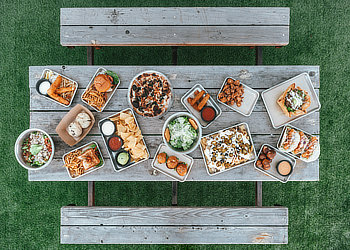Food Delivery Robot Services
Las Vegas, Nevada
Reshaping the food delivery

Imagine a world where your favorite meal is delivered not by a human driver but by a sleek, robotic companion that glides effortlessly along sidewalks and crosswalks. Soon, that dream will become a reality.
What is a food delivery robot?
A food delivery robot is an autonomous robotic device designed to transport food and beverages from a restaurant or a food preparation facility to a customer's location. These robots are equipped with sensors, cameras, navigation systems, and other technologies that enable them to navigate urban environments, avoid obstacles, and interact with pedestrians safely.
Even so, these robots run autonomously (without human control), the remote assistance can be activated - if necessary.
The size of a food delivery robot
Food delivery robots come in various sizes and designs. Some are small, wheeled robots that operate on sidewalks and pedestrian paths, while others might be larger vehicles that can navigate regular roads. These robots are often controlled remotely or use advanced artificial intelligence to plan routes, avoid traffic, and deliver items efficiently.
Benefits of a food delivery robot
The primary goal of food delivery robots is to streamline the food delivery process, reducing the need for human couriers and making deliveries more convenient for customers. They are particularly well-suited for last-mile deliveries, where the distance between the food establishment and the customer's location is relatively short.
Another benefit is that the food delivery robot is available 24/7.
Challenges of food delivery robot technology
Some of these challenges include:
• Safety and navigation: A critical challenge is ensuring robots navigate complex urban environments while avoiding pedestrians, vehicles, and other obstacles. Accurate mapping, real-time obstacle detection, and robust collision avoidance systems are necessary.
• Pedestrian interaction: Interacting with pedestrians in a socially acceptable and safe manner is crucial. Robots must communicate intentions to pedestrians, such as stopping or yielding, to prevent misunderstandings and accidents.
• Weather conditions: Adapting to various weather conditions, such as rain, snow, and fog, is challenging.
• Regulations and legal issues: Navigating complex and evolving regulations related to autonomous vehicles, pedestrian rights, and urban use is another challenge.
• Technical reliability: Maintaining high levels of technical reliability is crucial to prevent breakdowns during deliveries. Regular maintenance and monitoring are needed to ensure that robots perform as intended.
• Data privacy: Handling customer data, such as delivery locations and personal information, raises privacy concerns. Ensuring that data is collected and stored securely is essential for maintaining customer trust.
• Vandalism and theft: Robots operating in public spaces can be vulnerable to vandalism, theft, or tampering. Designing robots that are secure and resistant to such actions is essential to maintain their functionality.
If a food delivery robot is vandalized: Nevada laws
If caught on camera and arrested, a person who destroyed or looted a robot can face criminal charges. Nevada vandalism penalties may include fines, community service, spending time in a local jail, mandatory counseling, and suspension of driver's license. The person may also be required to clean up, repair, or replace the damaged self-driving food delivery robot.
Who operates the food delivery robots today?
Various entities own and operate self-driving food delivery robots, including technology companies, food delivery app-based services, and even traditional restaurants.
Here are some examples:
• DoorDash develops its food-delivery robot. In 2021, DoorDash received federal approval on two patents for small, compact self-driving delivery vehicles.
• GrubHub uses food delivery robots mainly on college campuses. One of their locations is the University of Nevada campus in Reno and Las Vegas. To get started, open the Grubhub app, choose from a range of restaurants labeled "Offers Robot Delivery," and then select the location to send your delivery. You can watch the food delivery robot's journey to your place via an interactive map.
• Uber Eats: The company deploys over 2,000 robots from Serve Robotics. In Nevada, Uber Eats robots operate on the UNLV campus.
• Starship: If you are on a college campus, you can download a Starship app, and the Startship food delivery robot will bring food to your door.
Delivery robots on city streets
Currently, most food delivery robots operate on college campuses, which is, as a rule, a closed space. But what if a restaurant or a grocery store is across the street from the campus? The food delivery robot has to cross the road or drive on a sidewalk, which can present several potential dangers.
One of the primary concerns is the safety of pedestrians. The presence of robots can create hazards and obstructions for foot traffic on crosswalks and sidewalks.
Second, the sidewalks and crosswalks must remain accessible to people with disabilities. A food delivery robot can block ramps, curb cuts, or other accessibility features.
Third, robots sharing crosswalks with bicycles, scooters, or other small vehicles can lead to conflicts between different modes of transportation.
Then, weather conditions, such as rain or flood, can affect robots' performance, potentially making robots less predictable and safe.
Finally, each city has local ordinances for using sidewalks and crosswalks, and robots must comply with existing laws.
Nevada: Senate Bill SB422
In 2023, Nevada's lawmakers created new public safety regulations to allow food delivery robots to operate on crosswalks and sidewalks everywhere. The state lawmakers passed a Senate Bill SB422, and starting from January 1, 2024, in Nevada, food delivery robots are allowed to run on sidewalks and crosswalks.
To comply with the new law,
a) The devices can not weigh more than 150 pounds when empty,
b) The food delivery robot can only travel 10 mph or less (walking speed), and
c) The robot operator must maintain liability insurance with a minimum of $100,000.
The bill also allows local governments to add additional laws and safety measures that can require device operators to obtain a business license.
Who is liable in case of an accident?
Under the current Nevada law, the negligent party (or rather their business insurance) is paying for all damages in the event of an accident.
It is worth mentioning that with autonomous vehicles - and a food delivery robot is one of them - most accidents are expected to fall into the category of product liability instead of driver or operator negligence.
We plan to follow the laws surrounding self-driving food delivery robot services in Las Vegas or Nevada very closely and update this article with new information as soon as it becomes available.
Stay tuned!
Last updated on January 3, 2025.

